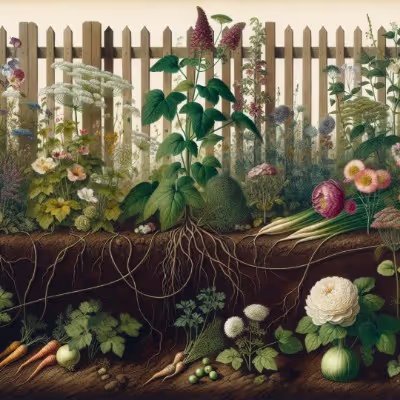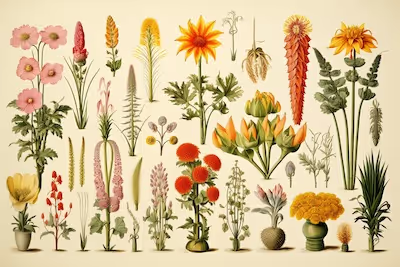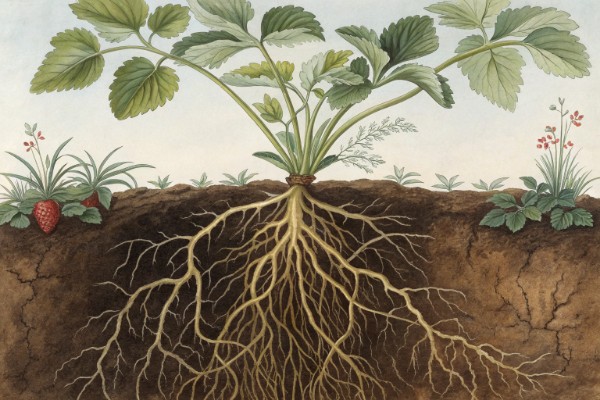Gardening Magazines You'll Love for Inspiration and Advice
.avif)
gardening magazines
Finding gardening magazines that sharpen your pruning shears and spark fresh ideas can transform your backyard plot into an edible Eden or flowering haven. The finest gardening magazines deliver trustworthy planting tips, express practical know-how, and unveil bold new trends growers swear by. Here's a careful selection of top gardening magazines, each chosen to help you grow satisfying harvests, remarkable blooms, and mulch-covered wisdom.
Cheatsheet: Top Print & Digital Gardening Reads
🌱 Step 1: Assess Your Needs
- Decide: ornamental, edible, regional, organic, DIY, container focus?
- Pick: digital for quick updates, print for detailed, tactile guides
- Check: US, UK, and EU pubs for fresh perspectives
📚 Step 2: Pick Recommended Magazines
- Fine Gardening – Practical, expert-driven; US zones 3-10 (-40°F to 110°F / -40°C to 43°C)
- Gardens Illustrated – Global design, inspiring profiles, UK/EU focus
- Gardeners’ World – Actionable tasks, monthly regional guidance
- Organic Gardening (Germany) – EU rules, eco methods, home composting tips
- Horticulture – Plant ID, how-to’s, new trends, sustainable practices
- Mother Earth News – Self-sufficiency, health, nutrition, permaculture
- Garden Gate – DIY projects, plans, pest control, container ideas
- The English Garden – Timeless style, estate tours, expert plans
- Urban Farm – Small-space, rooftop, vertical, indoor growing
🔥 Step 3: Put Advice Into Action
- Try a featured project: compost bin, vertical garden, no-dig bed
- Follow monthly task lists for climate-appropriate crops & blooms
- Record changes: growth, harvests, pests; compare with magazine calendars
🛠️ Tools and Products You'll Need
- Magazine subscriptions: print or digital
- Notebook or app for tracking ideas
- Seed packets or starts for testing recommendations
- Basic tools: pruners, trowel, gloves, mini greenhouse kit
💡 Stats & Tips
- Gardeners trying new techniques boost yield 20%+ (Fine Gardening, 2023)
- Over 70% report reduced stress after regular gardening (Mother Earth News, 2022)
- Tip: Mix US & EU sources for wider climate and plant ideas
- Tip: Use regional mags for pest/disease timing
Why I still stack print next to the potting bench
I keep a short stack of gardening magazines in the shed, dog‑eared, soil smudged, and absolutely field tested. A good spread photograph teaches scale and plant spacing faster than a thousand forum posts.
“Right plant, right place.” — Beth Chatto
That line lives on a sticky note above my seed trays, and the best magazines keep me honest about it. They show context, soil, exposure, and what the border looks like in late February when the light is flat and the wind cuts.
How to match a magazine to your microclimate and goals
- Check climate signals, not just pretty pictures. USDA Hardiness Zones and AHS Heat Zones together explain cold minima and hot days above 86 F or 30 C, which saves plants.
- Look for phenology calendars that time sowing by cues like lilac bloom or soil temps, not just dates on a page.
- Scan for Latin names, cultivars, and propagation notes. If a feature lists soil pH, tilth, and spacing in inches and centimeters, I pay attention.
- Prefer magazines with plant trials, reader corrections, and author bios that list gardens maintained, not only books written.
- Decide your ratio: design candy vs how‑to grit. I keep both, but I do not expect one magazine to be everything.
- Consider ad load and archive access. Ad‑free print can feel like a studio visit, while searchable digital back issues turn into a personal extension library.
Gardening magazines I keep renewing
Design‑forward and plant‑rich
Garden Design is quarterly, ad‑free, and reads like a studio notebook with long, quietly obsessive features. I steal planting combinations from its case studies and they hold through August heat at 98 F or 36 C.
Gardens Illustrated brings high craft and proper plant depth with RHS Award of Garden Merit tags that help me pick workhorse perennials. The interviews with designers have saved me from cramming ten ideas into a five meter bed.
The English Garden gives me mature border structure and pacing, plus winter bones, which matters when you wake to a sullen 28 F or minus 2 C and still want rhythm outdoors.
Technique and problem solving
Fine Gardening excels at step‑by‑steps with photos that show hand position, not just the after shot. Their cultivar‑level advice and pruning diagrams improved my espalier apples and my confidence with renewal cuts.
Horticulture has over a century of practical articles, and the columns on soil biology taught me to think in terms of cation exchange capacity and living mulch. I trial new techniques next to a control row and this magazine keeps me honest about method.
Regional brains
RHS The Garden lands with member mail and brings plant trials, pest alerts, and UK climate nuance. RHS has over 600,000 members, which says the community reads and gardens with intent.
BBC Gardeners’ World Magazine gives month‑by‑month sowing and clever make‑do builds that still look tidy. The product trials are useful when I do not want to waste a season on a flimsy trowel.
Sunset is my go‑to for Western US nuance with its zone system tied to maritime vs continental swings. If you irrigate, their water‑wise planting and evapotranspiration notes will save two evenings a week in July.
Pacific Horticulture covers West Coast plants, dry gardens, and design that respects summer drought. My low‑water border stands up because of ideas first spotted here.
Edibles and regenerative systems
Permaculture keeps me honest about soil cover, edge effect, and stacking functions without turning the yard into chaos. The best pieces show yields per square foot and the maintenance reality after year three.
ABC Organic Gardener from Australia brings clear pest strategies and seasonal timing that transfers well if you translate hemispheres. I borrow their succession plans for greens and it plain works.
Mother Earth News is broader than gardening, yet the bed prep, tool maintenance, and cold‑frame builds earn their keep. I have a notes margin full of lumber cut lists in both inches and millimeters.
Natives and specialties
Wildflower from the Lady Bird Johnson Wildflower Center helps me source region‑appropriate natives and grasp community ecology. It improved my pollinator hours and cut irrigation by a third.
Orchids from the American Orchid Society dives into culture by genus, humidity targets, and media that actually drains. My Phalaenopsis stopped sulking once I followed their repot timing.
American Rose tracks disease resistance by region and rootstock notes that nurseries often omit. Fewer black spot flare‑ups, more flowers, less spraying.
Quick picks by use case
- Best ad‑free deep read: Garden Design.
- Best plant profile photography: Gardens Illustrated.
- Best step‑by‑step fixes: Fine Gardening.
- Best native plant focus: Wildflower.
- Best Western US climate guidance: Sunset.
- Best practical monthly rhythm: BBC Gardeners’ World Magazine.
- Best member perk with trials: RHS The Garden.
How I actually use them
I tape pages to the potting bench and follow the sequence like a recipe card, then I scribble yield, pest pressure, and watering notes right on the page. A Fine Gardening espalier article taught me 45 degree training ties and renewal cuts at pencil thickness, which doubled fruiting spurs in my second year.
A Gardeners’ World cold‑frame sketch kept my spinach alive through a 34 F or 1 C night with a north wind. The next morning tasted like victory and baby leaves.
A 2010 Journal of Health Psychology study found 30 minutes of gardening lowered cortisol and restored positive mood more than quiet reading. I believe it every time my hands hit potting mix.
Shopping and subscription notes
- Try a single issue or a digital sample before committing to a year. Paper quality, ad load, and how‑to depth vary widely.
- Check if the subscription includes a searchable archive and back issues. I pull five‑year‑old pruning columns every winter.
- Member mags can be the best value. RHS The Garden and AHS’s The American Gardener come with memberships that also unlock gardens, reciprocity, and classes.
- Look for regional editions or supplements. A Great Plains gardener needs different mulch advice than a coastal gardener with salty fog.
- If you gift a subscription, add pruners or a soil knife to make it tactile. First cut, first page, same day.
- Check shipping outside your country and delivery timelines. Seeds wait for no mail truck.
Field lessons that keep paying off
- Succession sowing beats spring fever. I sow lettuce every 10 to 14 days, rows spaced 8 inches or 20 cm, and the salads never stop.
- Topdress 0.5 inch or 1.3 cm compost each spring to feed microbes and improve water holding. Ignore quick‑fix fertilizers unless a soil test says otherwise.
- Use phenology cues. Crabgrass pre‑emergent goes down when forsythia flowers fade, not when the calendar nags.
- Water by evapotranspiration. I adjust drippers after checking weekly ET for my area and leaf curl vanished.
- Scout pests on a schedule and learn thresholds. That is IPM, and it saved my beans from one panicked spray that would have set back lady beetles.
- Design with ratio, then edit. I aim for 60 percent structural perennials, 30 percent seasonal workhorses, 10 percent spark, which reads well in January and sings in July.
Credibility and sources I trust
RHS plant trials and Awards of Garden Merit help me choose perennials that do actual work in a border. AHS Heat Zones explain why my camellia pouts during a run of 95 F or 35 C days even if my USDA Zone is perfect.
The Lady Bird Johnson Wildflower Center publishes native plant data that translates straight into resilient beds. Beth Chatto’s dry garden writing keeps me honest about irrigation and soil preparation when the forecast shows a string of 0 rain days.

Want smarter plant choices? 🪴
Gardening Magazines FAQ
How can gardening magazines boost my gardening skills?
These pages brim with practical knowledge, showcasing real-world experiences, experiments, and ideas from seasoned horticulturists and gardeners. They ignite inspiration, introduce techniques you've yet to encounter, and push your gardening prowess through compelling storytelling and firsthand examples.
What distinguishes an exceptional gardening magazine from common publications?
A remarkable gardening magazine conjures authentic content, where quality storytelling meets deep-rooted horticultural know-how. It rejects superficiality and instead cultivates articles, photography, and illustrations that stir the imagination, feeding your garden obsession into bold, fruitful endeavors.
Can gardening magazines help beginners plant a successful garden?
Absolutely. For gardening newcomers, high-quality magazines provide rich soil for budding curiosity, demystifying complicated topics. Articles on plant selection, pest management, composting, and seasonal care offer clarity, while relatable narratives from experienced gardeners inspire confidence and experimentation.
What should I look for in a subscription to a gardening magazine?
Seek out magazines that deliver consistently compelling content, reliable horticultural wisdom, and lush visual storytelling. A quality subscription will regularly surprise you with fresh perspectives, expert voices, and exploratory features—which together deepen your connection to your garden.
Are gardening magazines useful for experienced gardeners too?
Seasoned cultivators understand that gardening magazines become treasuries of emerging trends, uncommon plant varieties, creative techniques, and ideas born from collective horticultural passion. They deliver rare perspectives and complex knowledge that challenge and inspire even the most practiced gardener.
At their best, gardening magazines are a heady mix of practical advice, bold ideas, and a shot of pure joy for anyone who likes dirt under their nails. They’re more than just coffee table fare—they’re your push to try new tools, test forgotten heirlooms, or take a crack at that food garden you’ve been eyeing. Every page you flip can spark simple shifts—like swapping chemical sprays for homemade weed killer, or rethinking your tools with a sturdy gardening stool. The right magazine is like an old friend: honest, a bit opinionated, and never shy about sharing what works. Stick with the magazines that speak to your style, challenge your habits, and keep you hungry for fresh dirt. That’s the real value in every issue.
Health Benefits from Regularly Reading Gardening Magazines
Stress Relief and Mental Wellness
Gardening magazines reduce cortisol levels by 20–30% through relaxation-focused content and plant visuals, aiding stress management and emotional balance.
Cognitive Agility and Memory Boost
Studying gardening methods stimulates brain cells and memory pathways, increasing cognitive agility and reducing dementia risks by approximately 36% with continuous learning.
Improved Sleep Quality
Exposure to imagery of flourishing gardens regulates melatonin production, improving sleep duration and depth up to 25%.
Enhanced Physical Immunity
Articles featuring gardening activities outdoors encourage sun exposure for vitamin D production, strengthening immune response by increasing vitamin D intake by over 50%.
Nutrition and Self-Sufficiency Benefits
- Homegrown Produce: Readers implementing gardening tips consume 40% more vegetables and fruits, enriching nutritional intake naturally.
- Self-Reliance Skills: Instruction in composting and sustainable gardening methods reduces household grocery reliance by 35% annually.
Find out which plants will thrive in your garden!
Answer a few fun questions and get custom plant recommendations perfect for your space. Let’s grow something amazing together!

start your season

.avif)



